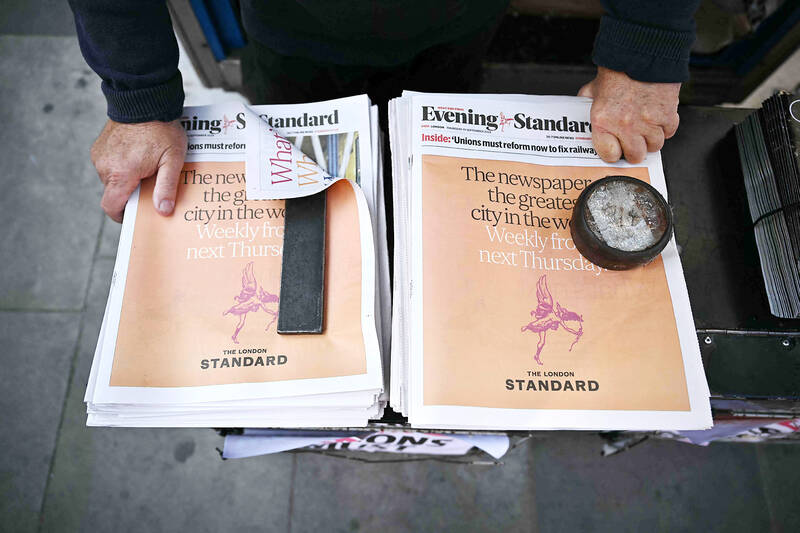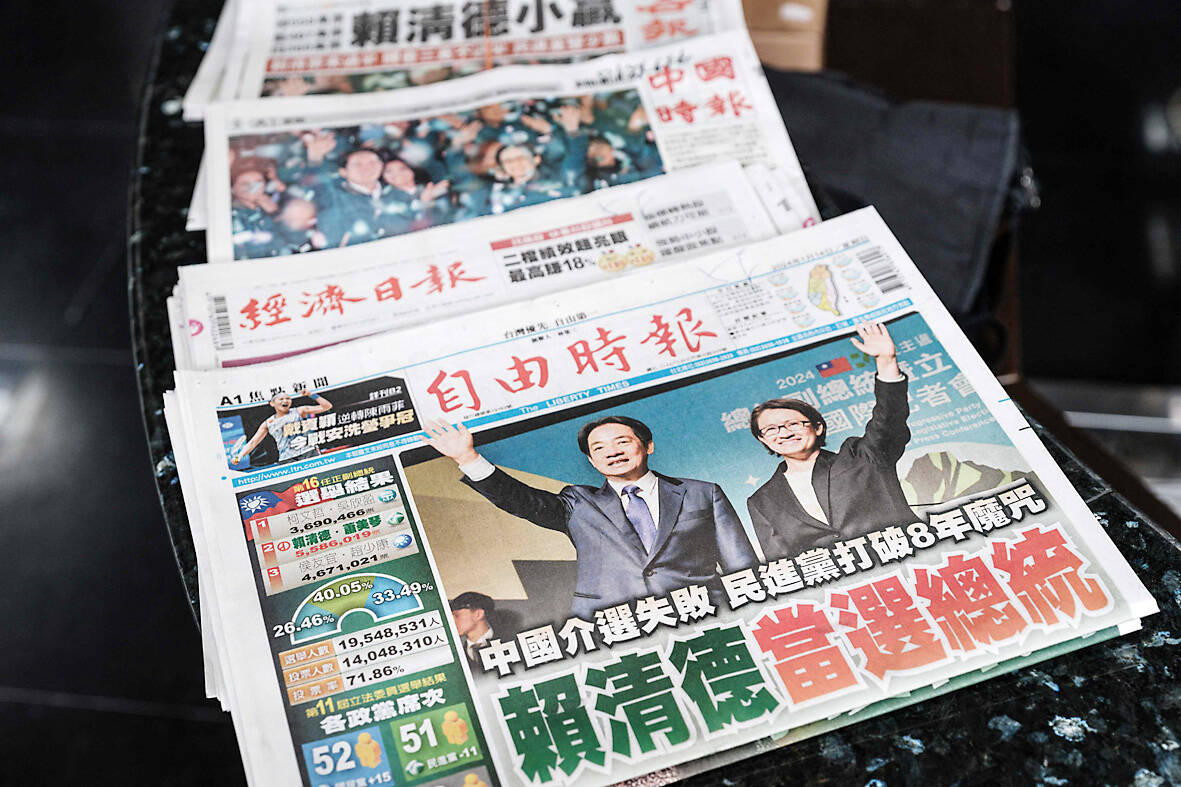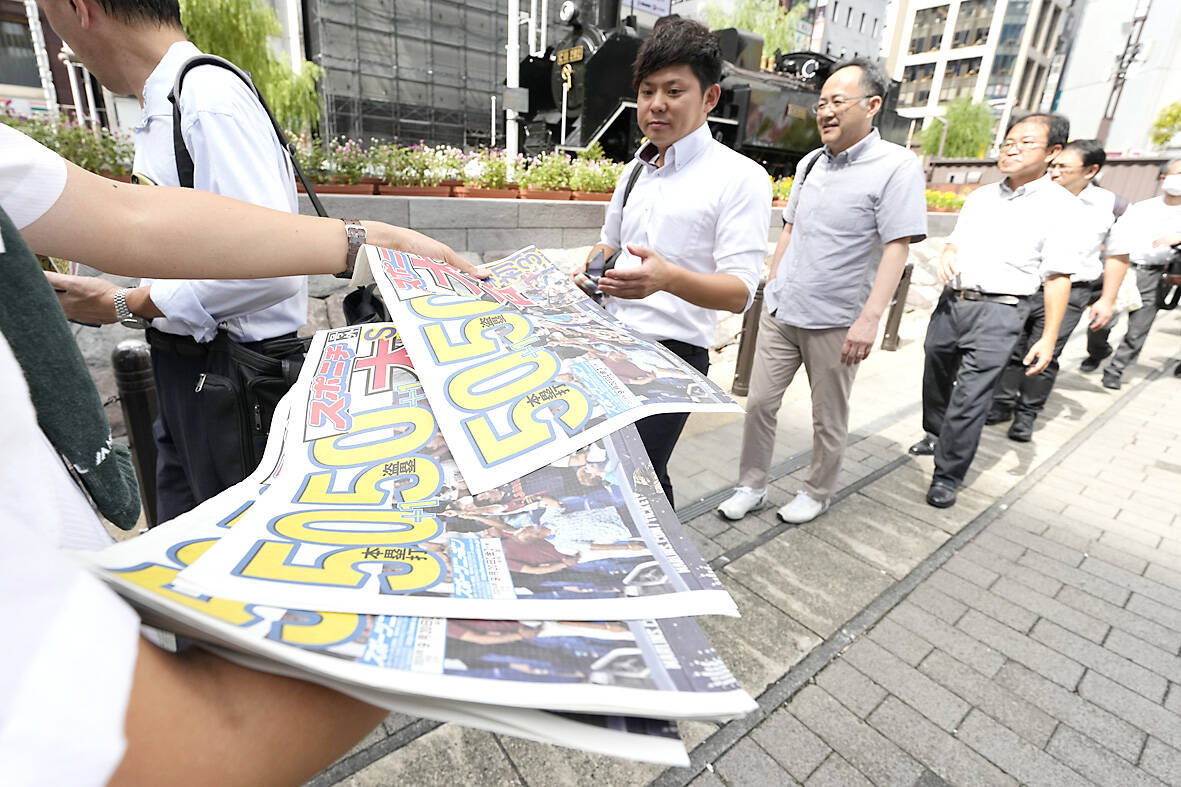From disinformation campaigns to soaring skepticism, plummeting trust and economic slumps, the global media landscape has been hit with blow after blow.
World News Day, taking place today with the support of hundreds of organizations, aims to raise awareness about the challenges endangering the hard-pressed industry.
‘BROKEN BUSINESS MODEL’

Photo: AFP
In 2022, UNESCO warned that “the business model of the news media is broken.”
Advertising revenue — the lifeline of news publications — has dried up in recent years, with Internet giants such as Google and Facebook owner Meta soaking up half of that spending, the report said.
Meta, Amazon and Google’s parent company Alphabet alone account for 44 percent of global ad spend, while only 25 percent goes to traditional media organizations, according to a study by the World Advertising Research Center.

Photo: AFP
Platforms like Facebook “are now explicitly deprioritizing news and political content,” the Reuters Institute’s 2024 Digital News Report pointed out.
Traffic from social to news sites has sharply declined as a result, causing a drop in revenue.
Few are keen to pay for news. Only 17 percent of people polled across 20 wealthy countries said they had online news subscriptions last year.

Photo: AP
Such trends, leading to rising costs, have resulted in “layoffs, closures and other cuts” in media organizations around the world, the study found.
ERODING TRUST
Public trust in the media has increasingly eroded in recent years. Only four in 10 respondents said they trusted news most of the time, the Reuters Institute reported. Meanwhile, young people are relying more on influencers and content creators than newspapers to stay informed.
For them, video is king, with the study citing the influence of TikTok and YouTube stars such as American Vitus Spehar and Frenchman Hugo Travers, known for his channel HugoDecrypte.
GROWING DISINFORMATION
The advent of artificial intelligence (AI) has renewed concerns about disinformation — rife on social platforms — as the tool can generate convincing text and images.
In the US, partisan Web sites masquerading as media outlets now outnumber American newspaper sites, the research group NewsGuard, which tracks misinformation, said in June.
“Pink slime” outlets — politically motivated Web sites that present themselves as independent local news outlets — are largely powered by AI. This appears to be an effort to sway political beliefs ahead of the US election.
As part of a national crackdown on disinformation, Brazil’s Supreme Court suspended access to Elon Musk’s X, formerly known as Twitter.
The court accused the social media platform of refusing to remove accounts charged with spreading fake news, and flouting other judicial rulings.
“Eradicating disinformation seems impossible, but things can be implemented,” Reporters Without Borders (RSF) editorial director Anne Bocande said.
Platforms can bolster regulation and create news reliability indicators, like RSF’s Journalism Trust Initiative, Bocande said.
ALARMING NEW PLAYER
AI has pushed news media into unchartered territory.
US streaming platform Peacock introduced AI-generated custom match reports during the Paris Olympics this year, read with the voice of sports commentator Al Michaels — fueling fears AI could replace journalists. Despite these concerns, German media giant Axel Springer has decided to bet on AI while refocusing on its core news activities.
At its roster, which includes Politico, the Bild tabloid, Business Insider and Die Welt daily, AI will focus on menial production tasks so journalists can dedicate their time to reporting and securing scoops.
In a bid to profit from the technology’s rise, the German publisher as well as The Associated Press and The Financial Times signed content partnerships with start-up OpenAI. But the Microsoft-backed firm is also caught in a major lawsuit with The New York Times over copyright violations.
‘QUIET REPRESSION’
With journalists frequently jailed, killed and attacked worldwide, “repression is a major issue,” said RSF’s Bocande. A total of 584 journalists are languishing behind bars because of their work — with China, Belarus and Myanmar the world’s most prolific jailers of reporters.
The war in Gaza sparked by Palestinian militant group Hamas’s Oct. 7 attack on Israel has already left a “terrible” mark on press freedom, Bocande added.
More than 130 journalists have been killed by Israeli airstrikes since Oct. 7, including 32 while “in the exercise of their duties.”
She said a “quiet repression” campaign is underway in countries around the world, including in democracies — with investigative journalism hampered by fresh laws on national security.

Most heroes are remembered for the battles they fought. Taiwan’s Black Bat Squadron is remembered for flying into Chinese airspace 838 times between 1953 and 1967, and for the 148 men whose sacrifice bought the intelligence that kept Taiwan secure. Two-thirds of the squadron died carrying out missions most people wouldn’t learn about for another 40 years. The squadron lost 15 aircraft and 148 crew members over those 14 years, making it the deadliest unit in Taiwan’s military history by casualty rate. They flew at night, often at low altitudes, straight into some of the most heavily defended airspace in Asia.

This month the government ordered a one-year block of Xiaohongshu (小紅書) or Rednote, a Chinese social media platform with more than 3 million users in Taiwan. The government pointed to widespread fraud activity on the platform, along with cybersecurity failures. Officials said that they had reached out to the company and asked it to change. However, they received no response. The pro-China parties, the Chinese Nationalist Party (KMT) and Taiwan People’s Party (TPP), immediately swung into action, denouncing the ban as an attack on free speech. This “free speech” claim was then echoed by the People’s Republic of China (PRC),

Many people in Taiwan first learned about universal basic income (UBI) — the idea that the government should provide regular, no-strings-attached payments to each citizen — in 2019. While seeking the Democratic nomination for the 2020 US presidential election, Andrew Yang, a politician of Taiwanese descent, said that, if elected, he’d institute a UBI of US$1,000 per month to “get the economic boot off of people’s throats, allowing them to lift their heads up, breathe, and get excited for the future.” His campaign petered out, but the concept of UBI hasn’t gone away. Throughout the industrialized world, there are fears that

Like much in the world today, theater has experienced major disruptions over the six years since COVID-19. The pandemic, the war in Ukraine and social media have created a new normal of geopolitical and information uncertainty, and the performing arts are not immune to these effects. “Ten years ago people wanted to come to the theater to engage with important issues, but now the Internet allows them to engage with those issues powerfully and immediately,” said Faith Tan, programming director of the Esplanade in Singapore, speaking last week in Japan. “One reaction to unpredictability has been a renewed emphasis on